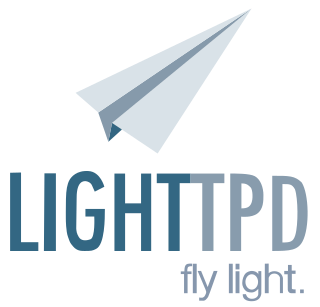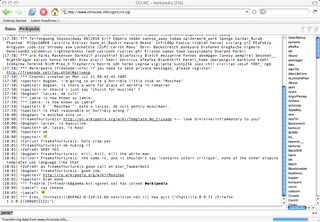
The Apache HTTP Server is a free and open-source cross-platform web server software, released under the terms of Apache License 2.0. It is developed and maintained by a community of developers under the auspices of the Apache Software Foundation.
The Comprehensive Perl Archive Network (CPAN) is a repository of over 250,000 software modules and accompanying documentation for 39,000 distributions, written in the Perl programming language by over 12,000 contributors. CPAN can denote either the archive network or the Perl program that acts as an interface to the network and as an automated software installer. Most software on CPAN is free and open source software.
In computing, Common Gateway Interface (CGI) is an interface specification that enables web servers to execute an external program to process HTTP/S user requests.
Server-side scripting is a technique used in web development which involves employing scripts on a web server which produces a response customized for each user's (client's) request to the website. Scripts can be written in any of a number of server-side scripting languages that are available. Server-side scripting is distinguished from client-side scripting where embedded scripts, such as JavaScript, are run client-side in a web browser, but both techniques are often used together. The alternative to either or both types of scripting is for the web server itself to deliver a static web page.

In computer networking, a proxy server is a server application that acts as an intermediary between a client requesting a resource and the server providing that resource. It improves privacy, security, and performance in the process.
mod_perl is an optional module for the Apache HTTP server. It embeds a Perl interpreter into the Apache server. In addition to allowing Apache modules to be written in the Perl programming language, it allows the Apache web server to be dynamically configured by Perl programs. However, its most common use is so that dynamic content produced by Perl scripts can be served in response to incoming requests, without the significant overhead of re-launching the Perl interpreter for each request.

The Microsoft Windows Script Host (WSH) is an automation technology for Microsoft Windows operating systems that provides scripting abilities comparable to batch files, but with a wider range of supported features. This tool was first provided on Windows 95 after Build 950a on the installation discs as an optional installation configurable and installable by means of the Control Panel, and then a standard component of Windows 98 and subsequent and Windows NT 4.0 Build 1381 and by means of Service Pack 4. The WSH is also a means of automation for Internet Explorer via the installed WSH engines from IE Version 3.0 onwards; at this time VBScript became means of automation for Microsoft Outlook 97. The WSH is also an optional install provided with a VBScript and JScript engine for Windows CE 3.0 and following and some third-party engines including Rexx and other forms of Basic are also available.

GNU Wget is a computer program that retrieves content from web servers. It is part of the GNU Project. Its name derives from "World Wide Web" and "get". It supports downloading via HTTP, HTTPS, and FTP.

WebGUI is an open-source content management system written in Perl and released under the GNU General Public License.

AWStats is an open source Web analytics reporting tool, suitable for analyzing data from Internet services such as web, streaming media, mail, and FTP servers. AWStats parses and analyzes server log files, producing HTML reports. Data is visually presented within reports by tables and bar graphs. Static reports can be created through a command line interface, and on-demand reporting is supported through a Web browser CGI program.

lighttpd is an open-source web server optimized for speed-critical environments while remaining standards-compliant, secure and flexible. It was originally written by Jan Kneschke as a proof-of-concept of the c10k problem – how to handle 10,000 connections in parallel on one server, but has gained worldwide popularity. Its name is a portmanteau of "light" and "httpd".

LAMP is an acronym denoting one of the most common software stacks for many of the web's most popular applications. However, LAMP now refers to a generic software stack model and its components are largely interchangeable.
A webform, web form or HTML form on a web page allows a user to enter data that is sent to a server for processing. Forms can resemble paper or database forms because web users fill out the forms using checkboxes, radio buttons, or text fields. For example, forms can be used to enter shipping or credit card data to order a product, or can be used to retrieve search results from a search engine.

CGI:IRC is a CGI program written in Perl that allows access to IRC via a web browser. It is designed to be flexible and has many uses such as an IRC gateway for an IRC network, a chat-room for a website or to access IRC when stuck behind a restrictive firewall.

Aptana, Inc. is a company that makes web application development tools for use with a variety of programming languages. Aptana's main products include Aptana Studio, Aptana Cloud and Aptana Jaxer.
Web2py is an open-source web application framework written in the Python programming language. Web2py allows web developers to program dynamic web content using Python. Web2py is designed to help reduce tedious web development tasks, such as developing web forms from scratch, although a web developer may build a form from scratch if required.
Greymatter is a free and open-source blogging software package, originally created by Noah Grey in November 2000. It was "the original opensource weblogging software". Noah Grey stopped maintaining it around 2002. Since then, it has been maintained by the community of users. It is one of the first software packages created for blogging, and had a large number of users. With the creation of WordPress and Google's Blogspot, its users have declined since 2005, but it is still in use.

Monitorix is a computer network monitoring tool that periodically collects system data and uses the web interface to show the information as graphs. Monitorix allows monitoring of overall system performance, and can help detect bottlenecks, failures, unusually long response times and other anomalies.
Internet censorship circumvention, also referred to as going over the wall or scientific browsing in China, is the use of various methods and tools to bypass internet censorship.
The following outline is provided as an overview of and topical guide to the Perl programming language:









